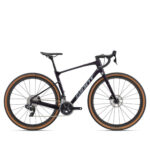Last summer, while tackling the rugged terrain of Ponderosa Way, the thought struck me: this is gravel bike territory. It seemed the cycling industry’s push for gravel bikes, cleverly disguised as marketing, was starting to resonate. And indeed, it worked on me. A casual visit to Bob’s Cycles of Roseville, after a trip to Home Depot, led me to a Felt V100 gravel bike on sale. Priced at an enticing $450—a significant drop from its near $1000 MSRP—it was hard to ignore. I paused, considering my options in the burgeoning gravel bike market. The Performance Access Old Turnpike and the Mongoose Selous Sport at Nashbar, along with numerous online offerings, also caught my eye in this price range.

Image alt text: Affordable Felt V100 gravel bike showcasing its aluminum frame and carbon fork, highlighting its entry-level appeal for gravel riding enthusiasts.
Weighing Options and Choosing the Felt V100 Gravel Bike
The Performance Access bike was a strong contender, particularly appealing, but availability became an issue. Locating a size 54 in San Diego was promising, yet my preference was to test ride a 56, and being on vacation complicated logistics. Ultimately, the $200 price difference compared to the Felt V100 tipped the scales, leading me to postpone the Performance bike.
Evaluating the landscape of available bikes, the Felt V100 emerged as the most compelling choice. Its strengths were numerous: a robust frame, a carbon fork shared with higher-end Felt V-series models like the V55 (priced up to $2,200), Tektro disc brakes, and a reliable Shimano Claris drivetrain. All these features were packaged at a remarkably competitive price point, making it an attractive entry-level gravel bike.
Returning to Bob’s Cycles, I discovered the specific V100 I had initially tried was sold. However, their Fair Oaks store had a few more in stock. They efficiently transferred one to Roseville, and the following day, I was back to pick it up. This particular bike was designated as a size 56, which the salesperson confirmed was suitable for my measurements. Interestingly, Felt’s sizing seems to prioritize the effective top tube length, as the seat tube measured only 52 cm.
Initial impressions of the fit were positive. While the reach from the saddle tip to the handlebars seemed potentially short, after some rides, it felt surprisingly well-proportioned. The extended STI brifter levers contribute to a comfortable reach. The only minor aesthetic detail was the significant amount of exposed seatpost, purely a cosmetic observation. Notably, the handlebar height aligned perfectly with the saddle level without any adjustments.
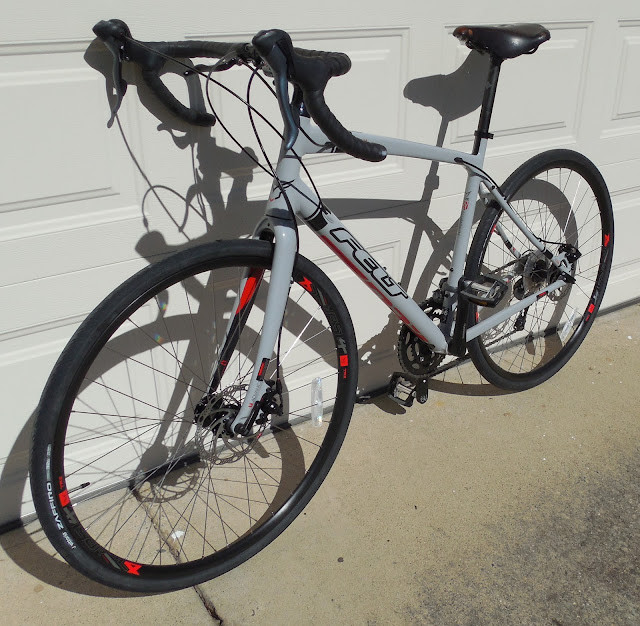
Image alt text: Close-up view of the Felt V100 gravel bike frame, showcasing its geometry and the integration of components like the carbon fork and disc brakes, elements contributing to its gravel bike versatility.
Exploring New Features: Disc Brakes and STI Shifters on a Gravel Bike
This Felt Gravel Bike incorporates features I’ve largely avoided for two decades: an aluminum frame, carbon fork, STI shifters, and disc brakes. However, embracing these modern components was part of the appeal. I was eager to experience these advancements firsthand. The frame and fork appear straightforward and durable, though only time will truly assess their longevity. The geometry seems relaxed, characterized by a head tube angle of.
The Shimano Claris shifters and derailleurs, while the entry-level STI offering, are performing admirably. The 8-speed cassette is actually advantageous for me, aligning with my existing collection of 8-speed cassettes. The compact road crank, featuring 50/34 chainrings paired with an 11-32 cassette, provides a sufficiently low gear for unloaded touring. However, the 50-tooth chainring feels somewhat excessive. I plan to replace it with a more versatile 46 or 48-tooth option later, optimizing the gear range for gravel riding. Interestingly, specifications for the V100 often mention an FSA Tempo crank with a square taper bottom bracket. Yet, both V100 models at Bob’s featured a Shimano “RS200” compact crank, also seemingly with a square taper BB. This discrepancy might explain the significant discount – perhaps a substitution due to FSA crank availability. A crank upgrade to a more performance-oriented option is under consideration.
My interest is particularly piqued by the disc brakes. The Tektro Mira mechanical disc brakes, while not top-tier, are functioning well initially. I view them as an excellent learning opportunity for disc brake maintenance before potentially upgrading to TRP Spyre mechanical disc brakes. The Spyres are reputed to be superior, employing dual-piston action compared to the Mira’s single-piston design. Hydraulic disc brakes are not currently on my upgrade path for this bike.
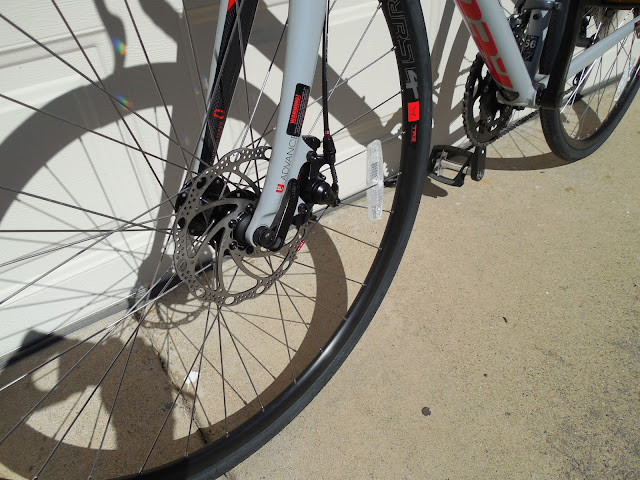
Image alt text: Tektro Mira disc brakes on the Felt V100 gravel bike, emphasizing the stopping power and modulation crucial for off-road cycling and gravel adventures.
Personalizing the Ride: Upgrades and Initial Road Tests
Upon bringing the Felt V100 home, the first modification was swapping the stock saddle for a Brooks B17, as the original appeared less than ideal. Next, the factory Vittoria 32c tires were replaced with my preferred 37c Continental Tour Rides. These Continental tires, measuring a true 35mm width, fit comfortably within the frame. Felt’s documentation suggests clearance for up to 40c tires, potentially even wider if they are a narrower profile. A notable feature is the exceptionally wide handlebars, measuring 49.5 cm at the ends and approximately 45 cm at the levers. This width feels surprisingly ergonomic and should prove beneficial in challenging, uneven terrain.
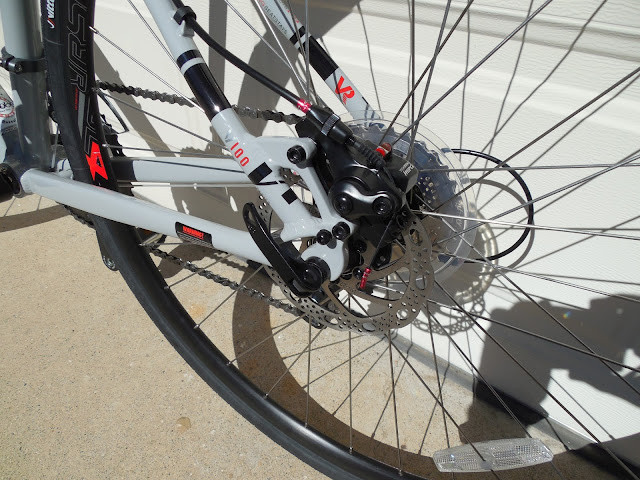
Image alt text: Rear disc brake and tire clearance on the Felt V100, illustrating the bike’s capability to accommodate wider tires for enhanced traction and comfort on gravel surfaces.
Subsequently, I installed familiar SPD pedals from my parts bin, added a Topeak Roadmorph pump, and a saddlebag, completing the initial setup. My rides on the Felt V100 have been exclusively on paved roads thus far, where it has performed comfortably. Adapting to the Shimano Claris shifting was quick, requiring only minor adjustments to the rear derailleur. The front derailleur’s “half click” trim function is effective. Riding on the brake hoods is comfortable, as is utilizing the slightly compact drops. Opting for a larger frame size might have resulted in an overly stretched riding position.
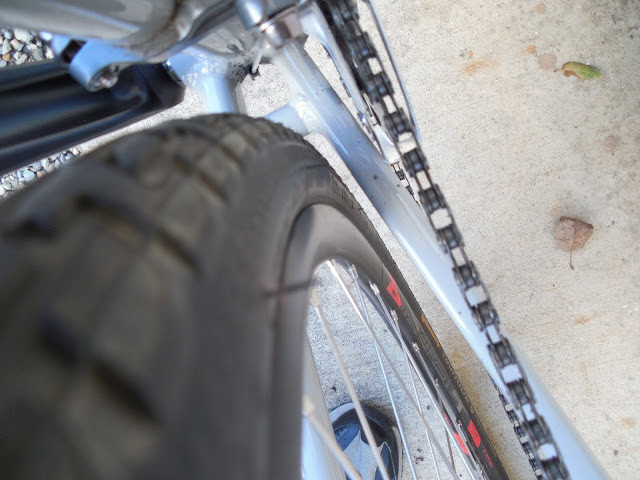
Image alt text: Tire clearance of the Felt V100 with 37c Continental Tour Ride tires, demonstrating the ample space for gravel-specific tires and comfortable gravel riding.
Back in the garage, I refined the rear derailleur and brake adjustments. The disc brake system appears straightforward to maintain and feels effective in its current setup. I am eager to test the Felt V100 on its intended terrain: Ponderosa Way!
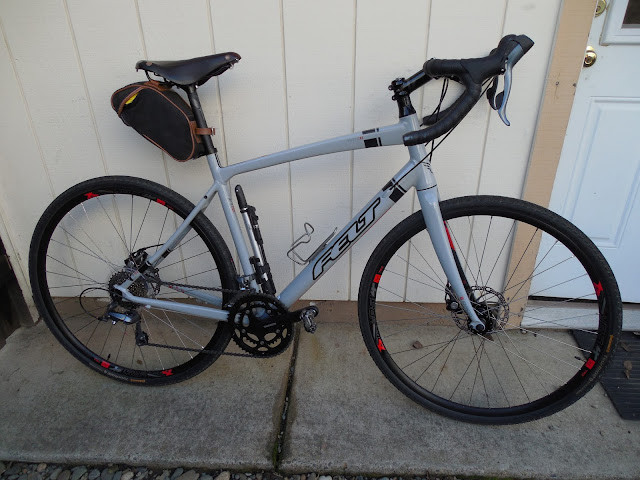
Image alt text: Fully equipped Felt V100 gravel bike ready for a ride, highlighting its setup with pump, saddlebag, and internal cable routing, showcasing its preparedness for gravel adventures.
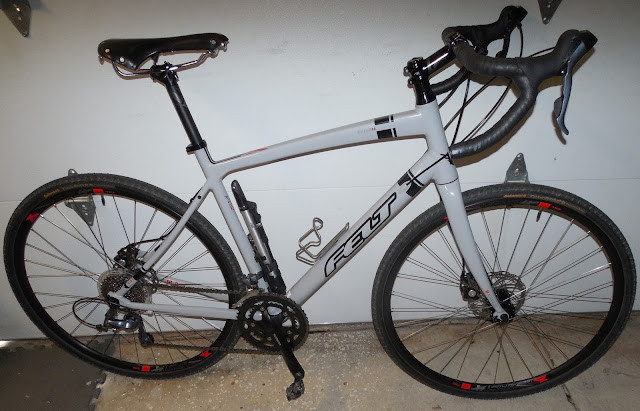
Image alt text: Upgraded saddle on the Felt V100, featuring a Brooks Swallow saddle for enhanced rider comfort and a touch of classic cycling aesthetics on this modern gravel bike.
Felt V100 Geometry Details (Size 56)
Date: September 18, 2017
For riders seeking specific geometry information on the Felt V100, particularly as this model is no longer in production, here are the measurements for the size 56, sourced from the Felt website:
- Size: 56
- Seat tube, (C-T): 520mm
- Head tube, horizontal, (effective?): 565mm
- Front Center: 621mm
- Wheelbase: 1041mm
- Chainstays: 430mm
- BB drop: 70mm
- HTA (Head Tube Angle): 71.5 degrees
- STA (Seat Tube Angle): 73.5 degrees

